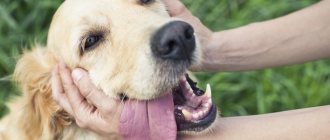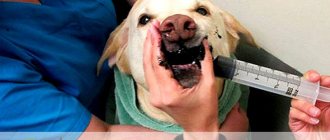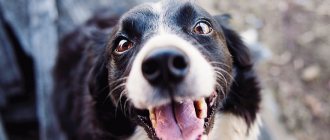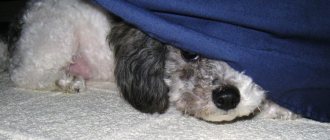Alina Vladimirovna Rykunova
veterinary therapist, specialization – dermatology, nutrition
Experienced veterinarians know how vulnerable a dog’s eyes are and how to protect them. Representatives of absolutely all breeds are prone to pathological eye lesions. The danger is that eye diseases in dogs sometimes lead to tragic consequences, including loss of vision. Accordingly, only veterinarians should treat a dog’s eyes.
- Horner's syndrome (recession of the eyeball)
- Conjunctivitis
- Cataract
- Ulcerative keratitis
- Retinal detachment
At the same time, it wouldn’t hurt for owners to know the signs and causes of eye diseases in dogs. Moreover, not all such pathologies manifest themselves in an obvious way.
Owners of dog breeds such as:
- dwarf breeds: Chihuahuas, toy terriers, Italian greyhounds, as well as Labradors, spaniels and collies, which are more often diagnosed with cataracts and retinal detachment;
- bulldogs, spaniels, chow-chows, boxers, St. Bernards, basset dogs, pugs - representatives of these breeds are more likely to exhibit abnormal direction of eyelid growth, as well as conjunctivitis and trauma to the cornea of the eye.
Puppies are more often susceptible to eye diseases at an early age, when their unstable immunity is still susceptible to pathological factors, such as bacterial and viral infections against the backdrop of crowded housing.
Types of eye diseases in dogs
In veterinary practice, a classification has been adopted that takes into account certain characteristics of dogs, the type of breed and its characteristics, as well as the nature of the origin of the disease. It is enough for the owner of the animal to know about the types of disease - they are either acute or chronic. In addition, there are varieties based on etiological characteristics:
- diseases of infectious origin - they are provoked by pathogenic agents of the microbiological environment. Inflammation and other manifestations of diseased eyes are observed under the pathogenic influence of viruses, fungi, and bacteria. Moreover, infections can develop both as a result of infection of the eyes themselves, and against the background of diseases of other organs;
- diseases of a non-contagious nature - as a rule, due to mechanical effects, the influence of temperature factors, climatic circumstances and conditions of detention;
- congenital eye pathologies - they arise as genetic complications or consequences, as well as due to pathologies of intrauterine development of the fetus.
Based on the causes of eye disease in dogs, it is customary to distinguish between primary and secondary pathologies. The first are independent diseases provoked by external factors; the latter are the result of an autoimmune problem, internal disorders in tissues and organs, the result of progressive infectious diseases of internal organs, tissues or systems.
| Diseases of the eyelids |
| Redness of the eyelids, thickening of the edge of the eyelid. The diseases develop in a bilateral form, accompanied by lacrimation and progressive inflammation. |
| Eyeball diseases |
| Extension of the apple beyond the edge of the eye orbit, frequent blinking. The dog is in tears. |
| Diseases of the conjunctiva |
| Sore eyes, purulent discharge, lacrimation. There may be redness of the whites, swelling and sagging of the eyelids. In some forms - the appearance of neoplasms and itching, anxiety. |
| Lens diseases |
| Cloudiness of the white of the eye. Deterioration of vision. Noticeable decrease in activity. |
| Diseases of the choroid and cornea |
| Significant pain in the eye area. Tearing occurs. As it progresses, the pigmentation of the eye changes and the pain intensifies. Partial or complete loss of vision is possible. |
| Retinal diseases |
| The rapid development of the inflammatory process, the appearance of discharge from the eyes, pain. Partial blindness or complete loss of vision is possible. |
| Glaucoma |
| The reaction of the pupil slows down, redness of the eyes and photophobia occur. Blindness develops. |
In puppies
In Spitz puppies, the cause of squinting of the eyes is most often congenital anomalies. In this case, you should immediately contact a veterinarian, who will decide which treatment to choose. If not treated in a timely manner, puppies may be left without an organ of vision.
If the puppy has lacrimation from birth, and daily toileting and medications prescribed by a specialist do not help, then the baby may have an obstruction of the tear duct.
In this case, a probing procedure is prescribed - cleaning the canal. This manipulation is done under general anesthesia and is painless for the puppy.
Diseases and problems of the eyelids
Diseases of the eyelids develop in a unilateral or bilateral form - in one eye or in both eyes at once. These diseases can be identified by the fact that the dog wants to scratch the eye area or shakes its head from side to side.
Blepharitis (inflammation of the eyelid)
Blepharitis is an inflammatory process of the eyelid, most often of a bilateral chronic nature. The cause is usually allergic irritants.
Symptoms of blepharitis are:
- hyperemia;
- itching, in which the dog rubs its eyes with its paws almost all day, especially in the acute form of the disease;
- squinting or if the dog's eye is completely closed;
- thickening of the edge of the eyelid.
Blepharitis can develop in different forms, therefore, according to signs and reasons, the following types are distinguished: seborrheic, allergic, demodectic, ulcerative, diffuse, scaly, external and chalazion.
Hurry up, choose a box and find out what gift awaits you
Discount on pet insurance
Promo code copied to clipboard
For treatment, rinsing of the mucous membrane of the eyelid is prescribed, as well as drug therapy using antibacterial, antihistamine, sedative, and antiparasitic drugs.
Turn of the century
Entropion of the eyelids most often appears as a genetic abnormality in the first year of a puppy’s life in the following breeds:
- Shar Pei;
- mastiff;
- Chow-chow.
This problem manifests itself in a sick dog with the formation of redness and profuse lacrimation. The complexity of this pathology lies in the lack of conservative treatment methods. Therefore, veterinary specialists perform surgical removal of entropion. You need to contact them as soon as you notice that your dogs have drooping lower eyelids. A situation where a dog's eye is partially swollen can be considered an alarming signal for a visit to the veterinary clinic.
Eversion of the century
Eversion of the eyelid usually occurs in breeds on the face of which movable folds of skin form. Also, a similar anomaly occurs in rocks with a wide orbital fissure.
The causes of eyelid inversion are considered to be mechanical injuries, consequences of operations, and genetic factors.
As the disease progresses, the dog experiences redness around the eyes, the inflammatory process spreads through the mucous membranes, and the eye may become watery. It is treated exclusively by surgical methods.
How to help your pet
If you notice alarming symptoms, act according to the circumstances. In some situations, the problem that has arisen can be eliminated on your own, but in most cases you will have to go to a veterinarian - or call him to your home.
When do you need a veterinarian diagnosis?
Diagnostics at a veterinary clinic will be required if there is a suspicion of an infection contagious to humans (rabies, leptospirosis) and if there are symptoms dangerous to the health of the animal. Be sure to seek help if your pet:
- He closes his eyelids tightly and whines pitifully when he tries to open them. Severe pain is typical for injuries and sharp objects stuck inside the eye socket.
- Hides in dark corners, avoiding any light sources. Photophobia is characteristic not only of inflammatory diseases, but also of rabies.
- Fever, suffers from repeated vomiting or diarrhea. Dehydration is very dangerous and can be fatal, especially in fragile puppies.
- He cannot open his eyelids because of the pus that has dried on them. The appearance of purulent exudate is a very alarming sign that accompanies the inflammatory process.
- Suffered an injury or chemical burn. Apply a sterile bandage to the damaged area and limit access to it using a protective collar.
- Suffered from prolapse or retraction of the eyeball. Both diseases can only be eliminated surgically. A similar situation is typical for inversion and eversion of the eyelid.
- He lost his pupil's reaction to light, and a greenish cataract appeared on his iris. Glaucoma cannot be cured, but its progression can be slowed down with medication.
The type of therapy will depend on the diagnosis. In most cases, medication and proper care will be enough for recovery.
When can you solve a problem yourself?
First, carefully examine the eye that is bothering your dog. If a blade of grass or other harmless object is stuck in it, carefully rinse the mucous membrane with running or warm boiled water. It is also permissible to use a cotton pad soaked in saline solution. You cannot use only cotton wool, as its fibers will aggravate the existing irritation.
To relieve pain from a thermal burn, use a cold compress, and to relieve itching and reduce inflammation, use tetracycline ointment or chloramphenicol. Perform all manipulations with clean hands to avoid introducing infection into the existing wound.
In case of an allergic reaction, the animal can be given an antihistamine. The drug Suprastin is suitable from the human first aid kit. The important thing to remember here is that allergies often return, so don't wait to see your veterinarian after your symptoms have subsided.
Veterinarian's medication prescriptions
Antibiotics and antivirals are used to treat infections. All other drugs are prescribed to relieve symptoms and may include:
- anti-inflammatory;
- antihistamines;
- cholinomimetics that improve the outflow of intraocular fluid (for glaucoma);
- painkillers;
- acaricidal;
- artificial tear substitutes;
- immunomodulators;
- glucocorticosteroids.
If the dog squints one eye, then the prescribed drops will still have to be instilled in both. Regular care, including soaking dried crusts, will help avoid injury to neighboring areas.
Surgical intervention will have to be resorted to when:
- deeply embedded foreign bodies that are not amenable to tweezers;
- follicular conjunctivitis;
- enophthalmos and exophthalmos;
- improper eyelash growth;
- ectropion and entropion.
During the rehabilitation period, it is necessary to monitor the condition of the operated area, avoiding inflammation and suppuration. Treat the wound with special ointments only if your doctor advises it. Moisturizing slows down tissue regeneration, so it is best to avoid it.
Features of treatment for puppies
Due to their age and weak immunity, puppies are more susceptible to illness and many medications. It is recommended to immediately show small pets to a veterinarian, as most standard medications are not suitable for them. The dosage also requires adjustments, so you should not self-medicate on the advice of friends.
Diseases and problems of the eyeball
All kinds of eyeball problems are observed in dogs of those breeds whose anatomy is manifested by a discrepancy between the sizes of the orbit and the eyeball - Pekingese, Shih Tzu and others. Puppies usually get sick until they are 8-12 months old, although adults can also suffer from this.
Horner's syndrome (recession of the eyeball)
Horner's syndrome is a disease that is caused by a violation of the innervation in the eyeball. The main symptom is the retraction of the apple and a constricted pupil. The eyelid of an eye affected by Horner's syndrome is noticeably drooping.
The dog blinks frequently, and prolapse of the third eyelid occurs. Retraction of the eyeball is treated with surgical methods.
Eyeball luxation
Exophthalmos (dislocation of the eyeball) is a consequence of genetic factors or trauma to the organs of vision or head. With such a dislocation, the dog’s eye is greatly enlarged, and it extends beyond the edge of the orbit. It is reduced surgically in an outpatient setting at a veterinary clinic.
Diagnostics
To make a diagnosis, the veterinarian must take a complete history and perform a physical examination of the patient. Then an ophthalmological examination is performed: examination of the eyelids, anterior and posterior chambers of the eye, the surface of the cornea, tonometry, fluorescein test and Schirmer test (determining the production of tear fluid). In dogs with severe pain, a detailed examination of the diseased eye is possible only after anesthesia, and some animals may require sedation.
Additionally, if necessary, ultrasound examination of the eye, cytological examination, CT and MRI of the head are prescribed. If systemic diseases are suspected, a general and biochemical blood test and blood pressure measurement are performed. Bacteriological or virological testing may be recommended.
Diseases and problems of the conjunctiva and lacrimal apparatus
Diseases affecting the conjunctiva and/or lacrimal apparatus usually occur in representatives of long-haired breeds or in individuals with a large eye orbit. Poodles and Yorkshire terriers often suffer - they often have acute inflammation of the conjunctiva.
Diseases of the conjunctiva can be infectious or non-infectious, or caused by allergenic components.
Conjunctivitis
Conjunctivitis is provoked by foreign objects falling on the mucous membrane and on the surface of the third eyelid. The disease develops in acute and chronic forms. Symptoms of conjunctivitis include redness of the whites, the formation of purulent discharge, restless behavior, and the eyelid may sag slightly.
For treatment, surgical and medicinal methods are used aimed at eliminating the cause, relieving allergic irritation, and calming the animal. Foreign objects that caused conjunctivitis are removed from the eye. Treatment must be justified by a veterinarian depending on the classification of conjunctivitis. It can be of the follicular, purulent and allergic type, and can also develop as a secondary pathology due to eye injury.
Purulent conjunctivitis
The purulent form develops against the background of the activity of pathogenic microflora:
- bacteria;
- fungi;
- viruses.
Purulent conjunctivitis often results from infection with pathogens of dangerous diseases (for example, canine distemper). For such reasons, dogs' eyes turn red or purulent discharge appears.
For treatment, external agents are used in the form of ointments, saline solution, and eye drops. At the same time, injectable antimicrobial drugs are prescribed.
Allergic conjunctivitis
Allergic symptoms of conjunctivitis are easy to distinguish - this problem is manifested by profuse lacrimation and redness around the eyes. This form is treated with the use of antihistamines and anti-inflammatory drugs. An allergic form occurs when pollen, sand, pesticides and other irritants get into the eyes.
Follicular conjunctivitis
This form is manifested by the formation of small vesicular neoplasms on the inner surface of the eyelid. The mucous membrane becomes swollen, and the dog experiences redness around the eyes.
With this form, only complex therapy with surgical methods can cope with the disease.
Keratoconjunctivitis
Keratoconjunctivitis is also called dry eye syndrome - the eye may become swollen and red. Veterinarians cite dust, microorganisms, and damage/clogging of the lacrimal gland as the causes. Bulldogs, spaniels and pugs are more susceptible to this disease.
In a dog with keratoconjunctivitis, neoplasms, ulcerative lesions, suppurations are observed, and structural abnormalities of the cornea are observed. The animal begins to blink frequently, the eyes may become swollen, painful, and inflamed. It is noticeable that the dog has a red spot on his eye.
Based on the diagnostic results, the veterinarian prescribes lavage, bougienage of the lacrimal canal and medications.
Physiological reasons
This group includes everything that is not related to internal processes. In this case, the disorder occurs due to external factors affecting the visual organ.
Entry of a foreign object
One of the most common reasons why a dog squints its eyes is due to a foreign object. During a walk, a small blade of grass, a piece of leaf, a cobweb or dust may stick to the mucous membrane. Most often, curious puppies suffer from this problem, sticking their little faces everywhere.
Injury to the cornea or eyelid
Mechanical damage to the cornea and eyelid occurs due to injuries and bruises received during active games or fights. The pet may run into a sharp stick, run straight into a wall, or compete with another dog. The risk group includes breeds with bulging eyes.
Burns
Chemical and thermal burns are most common in dogs. The first group includes cases of damage from aggressive household chemicals, and the second - from direct sunlight.
Photophobia
An inadequate reaction to light is not an independent pathology, but is a symptom of it. Avoidance of direct sunlight is characteristic of many infectious and ophthalmological diseases. Only an examination by a veterinarian will help you understand the real cause of the illness.
Diseases and problems of the lens
Pathologies of this category in veterinary ophthalmology are considered the most dangerous for dogs of all breeds. Animals of any age category suffer, regardless of gender, health status, or breed.
Any disease of the eye lens is detected based on clouding of the protein and signs of visual impairment. The prognosis for such diseases is unfavorable, since there is practically no productive therapy for lens pathologies.
Cataract
One of the most common and most unpromising diseases in terms of treatment is cataracts. This disease most often occurs in the following age groups of dogs:
- puppies under 1 year of age;
- adults starting from 8 years of age.
Between the ages of one and eight years, animals are at risk of developing cataracts. The juvenile form of cataracts is more typical for breeds such as:
- dachshund;
- poodle;
- Labrador;
- bull terrier;
- Staffordshire Terrier.
The age-related form of cataracts in dogs after 8 years can develop in all breeds. This ophthalmological problem occurs against the background of primary diseases: for example, with progressive glaucoma, dysplasia or retinal atrophy.
Treatment methods for this disease have not been developed for dogs. A surgical operation may be performed to:
- removal of damaged eye lens;
- implantation of an artificial lens.
Currently, cataract surgery is performed using ultrasound technology, as well as phacoemulsification, a minimally invasive operation using a microscopic incision.
Bright light, strong wind and other external factors
Dogs reflexively squint when:
- Bright sunlight.
- Bright reflected light.
- Strong winds, especially during the flowering period of grasses.
- Fog, haze, smog.
Additionally, squinting is a way to focus vision even if the dog does not suffer from eye problems. A dog may squint if it is concentrating, listening to something, hunting, tracking, thinking, trying to detect the source of a sound or other stimulus.
Light irises
If you start looking at breed standards without sorting, you will notice that most dogs have eye colors that fall within the brown spectrum. Dark irises are not so receptive to light; some of the light rays are simply absorbed by them, which reduces irritation of the optic nerves.
Dogs with blue, gray and colorless (albino) eyes squint even if other dogs do not experience discomfort. The reason is that light irises increase the brightness of light, which leads to discomfort and pain.
Diseases and problems of the choroid and cornea
The choroid and cornea of the eye may suffer mainly from the progression of inflammatory processes. Failure to promptly contact a veterinary ophthalmologist can lead to complete blindness of the dog. Moreover, this can happen in a short period of time, since such pathologies have intensive development dynamics.
Ulcerative keratitis
In the eyes of an animal, ulcerative keratitis develops as a result of sun or thermal burns, when exposed to mechanical forces during impacts, or when foreign objects enter the eye. In addition, ulcerative keratitis is a secondary disease against the background of allergic abnormalities, vitamin deficiency, bacterial and viral infections. Another reason for this pathology is endocrine diseases (for example, diabetes mellitus).
With such a lesion, tearing develops. In this case, the dog rubs its eyes with its paws, which indicates itching, discomfort and the presence of foreign bodies on the cornea. The eye may be very sore. Blue eye syndrome also occurs when the pigmentation of the pupil changes under the influence of pathological factors.
In these circumstances, veterinarians prescribe drug therapy with antimicrobial, antihistamine, painkillers, as well as external agents to localize the inflammatory process.
Uveitis
Uveitis is an inflammatory ophthalmological disease. It is accompanied by damage to the choroid of the eye and disruption of the blood supply to its tissues.
Signs of intense inflammation of the irises are changes in their color, fear of bright light, half-closed red eyelids, and decreased visual acuity. Uveitis occurs due to injuries to the head and eye area, viral and bacterial infections.
If a dog's eye is inflamed in the area of the iris, anti-inflammatory drugs are mainly used to treat uveitis, as well as drugs to reduce pain.
Associated symptoms
Depending on the cause, squinting may be associated with other worrying symptoms. These include:
- apathy or aggression;
- poor appetite and sleep disturbances;
- redness and inflammation of the conjunctiva;
- excessive tearing or the appearance of purulent discharge;
- clouding of the iris, strabismus and prolapse of the third eyelid;
- increase or decrease in temperature;
- enlargement of the pupil and the appearance of a greenish cataract;
- gluing of eyelashes and formation of erosions on the cornea;
- repeated vomiting and bloody diarrhea with the smell of rot;
- yellowing or blanching of the mucous membranes.
Because there is a wide range of possible causes, do not rush to make a diagnosis before contacting your veterinarian. Even an ordinary blade of grass can lead to quite serious consequences if an infection gets into the scratched wound. Limit your actions to first aid and be sure to take your pet for examination.
Retinal diseases and problems
This category of ophthalmic problems in dogs is common to all breeds. Dogs of all age categories suffer from similar pathologies, but animals over 5-6 years of age suffer more than others. The causes of such diseases are injuries to the eyes and muzzle, hemorrhages in the skull. Often diseases develop at the genetic level and are hereditary.
Retinal detachment
The retina can peel off under the influence of traumatic factors, when exposed to harsh bright light, when looking at the sun or too bright sources of fire. Retinal detachment can occur in all breeds of dogs, regardless of age.
This disease is characterized by a rapid course and a cautious prognosis. It can result in the dog becoming completely blind if timely treatment measures are not taken. For this purpose, a course of drug therapy is prescribed using anti-inflammatory and antibacterial drugs. At the same time, surgical manipulations can be prescribed, including ophthalmic surgery.
Retinal atrophy
Retinal atrophy is more depressing for the dog and its owner, since it cannot be treated. It manifests itself as a gradual loss of vision, initially in darkness. Subsequently, vision becomes weak even in daylight.
There is no effective treatment for canine retinal atrophy.
How to carry out treatment
Based on the fact that squinting in dogs, accompanied by pain and pain in the eyes, is the most unpleasant symptom that interferes with the normal pace of a dog’s life, it is worth starting from them. When treating sudden and irregular squinting at home, you need to check the eye for objects or damage in the eye. If the dog allows itself to be touched, it is a good idea to gently rinse the eyes with saline or eye care liquid using sterile wipes or cotton pads. This will help rid your dog of annoying dust particles and tiny debris.
In cases where the dog does not allow you to approach him and does not allow you to touch his head and eyes, you can almost absolutely say that he has eye injuries. It is strictly prohibited to treat them yourself in this situation; this should be done by a veterinarian in specialized conditions. In this case, before the examination, it is better to protect the pet from harsh or bright lighting, put it to rest and exclude the possibility of aggravation of unpleasant sensations.
Currently reading:
- Actions to take in case of an epileptic attack and a shaking dog
- Recommendations for obedience of a dog if it growls
- Thyroid dysfunction in dogs (hypothyroidism)
- Pinched nerves and subtle symptoms in dogs
Symptoms of diseases of internal organs
In some cases, suppuration in a dog’s eyes may be associated directly with an eye disease, but with a disease of the internal organs. Therefore, it is worth considering the most common diseases, the symptoms of which can be seen in your pet’s eyes:
| Disease | Image | Symptoms |
| Piroplasmosis | In this case, all the mucous membranes of the animal become inflamed. The disease is associated with numerous tick bites | |
| Ataxia | One of the symptoms is continuous streams of tears from the pet’s eyes. Initially, this is a disease of the brain, or more precisely, of a separate part of it: the cerebellum. | |
| Infectious hepatitis | There is blurred vision and the appearance of yellow spots in the white area. Accordingly, this is a liver disease |
With such diseases, there is no need for eye treatment, since the symptoms will disappear only after direct treatment of the disease.
Itching in a dog's eyes due to keratitis
Keratitis is another condition that can affect the cornea. In this case, it causes inflammation, which makes it cloudy and causes severe watery eyes, light intolerance (photophobia), bulging of the third eyelid and explains why the dog scratches its eyes so much. There are several types, and all of them are serious as they can lead to blindness. Here they are :
- Ulcerative keratitis : This inflammation of the cornea is a consequence of other diseases, such as corneal ulcers. The cornea begins to dim until it becomes cloudy and turns white.
- Infectious keratitis : Occurs when a bacterial infection complicates another condition, such as a corneal ulcer or ulcerative keratitis. This causes a purulent discharge and the eyelids appear swollen. Fungi can also complicate the picture (fungal keratitis).
- Interstitial keratitis : It is also known as blue eye because a bluish-white film forms on the eye. The cause is an infectious hepatitis virus.
- Vascular keratitis : Blood vessels and connective tissue grow into the eye. This process can sometimes be associated with pigmentary keratitis, in which melanin (pigment) is deposited in the cornea.
Of course, this requires veterinary care and treatment with medications and/or surgery.
And the second article : Maria Besteiros.
Eye drops and ointments for allergic conjunctivitis
In case of allergic conjunctivitis, it is necessary, first of all, to eliminate or minimize contact with the allergen. To relieve symptoms, antihistamine H1-blockers are prescribed to suppress the allergic reaction:
- drops Allergodil, Opatanol, Cromohexal, Lecrolin, Ketotifen, etc.;
- decongestant and vasoconstrictor drops (Vizin, Visomitin, Oksial);
- eye ointments, incl. hormonal (Hydrocortisone, Dexamethasone);
Tablets of systemic antihistamines (for example, Tavegil, Suprastin, Loratadine and their analogues) may also be prescribed.
Features of the treatment of conjunctivitis
This disease is quite common among many dog breeds, and even manifests itself in different ways. In this regard, various treatment methods and, accordingly, drugs were invented:
| Type of conjunctivitis | A drug | Image | Treatment methods |
| Catarrhal | Ichthyol and Tetracycline ointment | Tetracycline ointment | Apply to the eye 3 times a day. Preliminary anesthesia with Novocaine |
| Follicular | Albucid and Dexamethasone | Albucid | Eye drops 3 times a day. For each dose, 4 drops should be instilled. |
| Keratoconjunctivitis sicca | Optimmune | Optimmune | The ointment should be applied twice a day after preliminary rinsing with plain water. The course of treatment is quite long - about two weeks |











